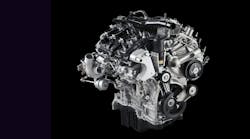SinterCast reports that its customers’ second-quarter 2017 series production of compacted graphite iron hit a new, annualized record high of 2.2 million “engine equivalents,” or 100 million kg of CGI. The increase is attributable mainly to the rebound in Ford V6 diesel engine production after a retooling interlude as part of a capacity expansion for that program, as well as production increases for industrial power engine components at the Caterpillar foundry in Mapleton, IL.
Stockholm-based SinterCast is the developer and licensor of the most widely used production and process control technology for CGI -- a specialty grade of cast iron that has greater tensile strength, stiffness, and fatigue strength than gray iron or aluminum. It is increasingly popular with diesel and gas engine manufacturers seeking to reduce weight, noise, and emissions for their designs.
Despite the positive trend, the developer noted that its half-year annualized series production is 1.2% lower than the full-year output posted for 2016. While the current production rate is stable, the group’s year-to-date revenue is lower by approximately 10%, year-over-year, which it said is due to a 25% decrease in year-to-date shipments of its proprietary sampling cup: those shipments are expected to increase during the remainder of this year.
More generally, SinterCast reported that its 2Q production results mean that in three of the last five quarters it has equaled its all-time high of 2.2 million engine equivalents. “This shows the strength of the underlying series production foundation that is diversified over approximately 65 programs, providing a profitable base and a stable platform for future growth,” SinterCast president and CEO Dr. Steve Dawson wrote in comments released with the group’s quarterly statement.
The forecast for SinterCast CGI production in remainder of 2017 is positive, according to the developer. It cited potential increases in production totals for Ford 3.0-liter V6 diesel engine, in advance of that engine’s availability in the new diesel F-150 pick-up; and a return to series production for Fiat Chrysler’s 3.0-liter V6 diesel engine later this year.
SinterCast also looks forward to production starting in the fall in China for Jiangling Motors’ new cargo truck, which will be powered by 9.0- or 13.0-liter SinterCast-CGI cylinder block and head.
Noting recent orders for CGI system updates at the Tupy and Teksid foundries in Mexico, SinterCast indicated that “several new installation discussions“ are ongoing for CGI process control systems, and for the expansion of existing installations to increase capacity or to incorporate additional process control features.”
The group also reported that its new ladle, cast, and operator “tracking” technologies have been well received by foundries, and that discussions are ongoing for CGI applications, gray and ductile iron foundries, steel mills, and for other metal processing applications.









